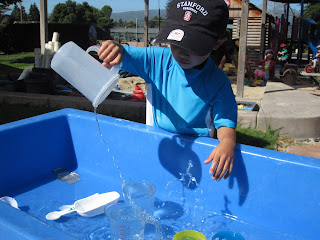By Marie Faust Evitt
My sons loved to splash in the bathtub and wading pool when they were young but I see now I missed an opportunity to take their play to a deeper level of exploration. When I began teaching preschool years later, I saw how playing with water provides the perfect opportunity for promoting scientific inquiry at school and at home.
When children play with water they naturally ask questions: What will happen if I pour water from this container into this one? What if the container is already full of water? When they have lots of time to try pouring again and again with a variety of containers, children can begin to develop their own theories and understanding.
Water exploration is especially fun in summer when you don’t have to worry children will get cold if they get wet. During our preschool summer program we have several water tables and tubs set up every day because they are so popular. It’s easy to encourage water exploration at home, too, in the kitchen sink and bathtub, playing outdoors with a garden hose and in a wading pool. Note: it is essential that children have adult supervision at all times when playing with water.
Exploring Water with Young Children by Ingrid Chalufour and Karen Worth provides an in-depth look at water table science and provides detailed instructions for setting up and introducing materials over days and weeks so children can experience many different actions of water – flowing, dripping, spilling, splashing and bubbling.
At our preschool program we begin with different size containers in the water tables, including a variety of plastic measuring cups. On other days we add clear plastic tubing and funnels to introduce the idea of carrying water like pipes do and use a metal fence to help support the tubing so children’s hands are free. We introduce items that squirt and make drops such as turkey basters, eye droppers and plastic squirt bottles. We later introduce bottles and cups with holes punched in them so children can observe streams of water.
You can help deepen children’s thinking by asking questions such as:
· How do you think the baster works?
· What happens when you pour the big container of water into the little measuring cup?
· What do you notice about the bubbles in the tube?
After children have had much time for free explorations you can propose challenges:
· How can you move the water from this tub to this one?
· Can you make water go up a tube?
· Can you stop the water flowing?
Asking children to describe and draw what they see happening with the water, helps focus their attention and builds language and literacy. Math is naturally part of water exploration as children compare volume of different containers.
I enjoy introducing children to water exploration by reading a few pages at a time of I Get Wet by Vicki Cobb. Water Dance by Thomas Locker is a poetic look at different forms of water.
How do you encourage children's explorations as they are splishing and splashing?


No comments:
Post a Comment